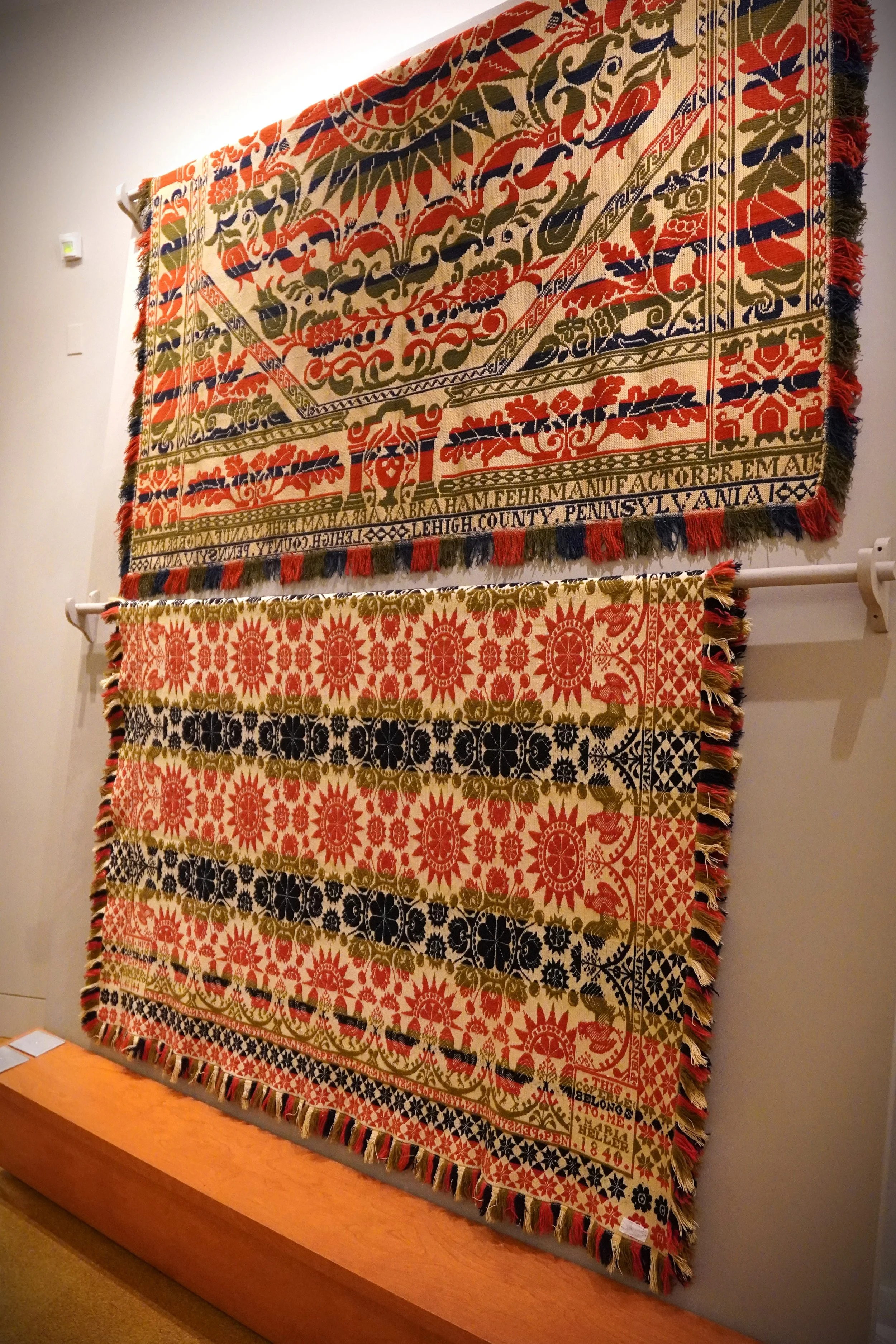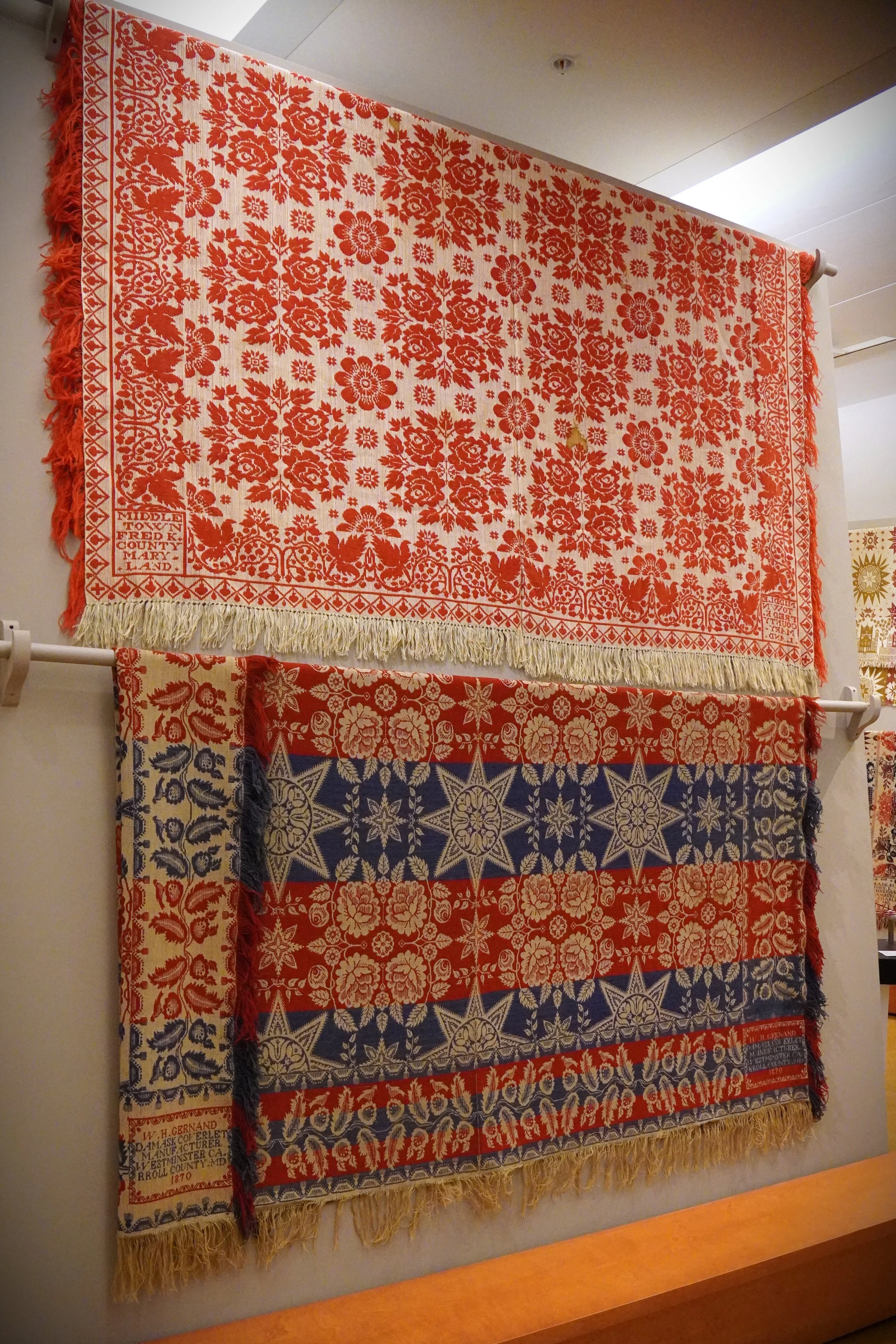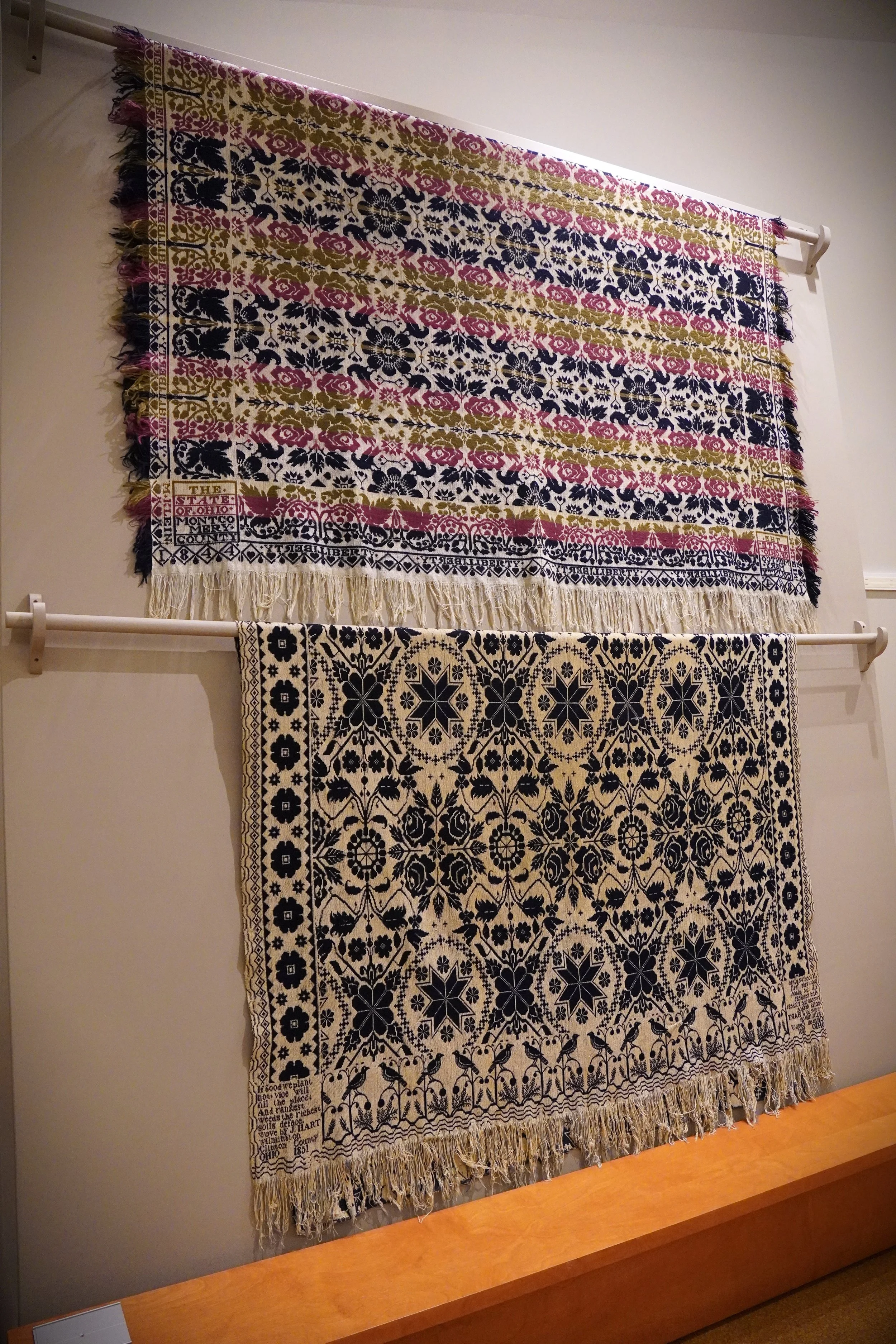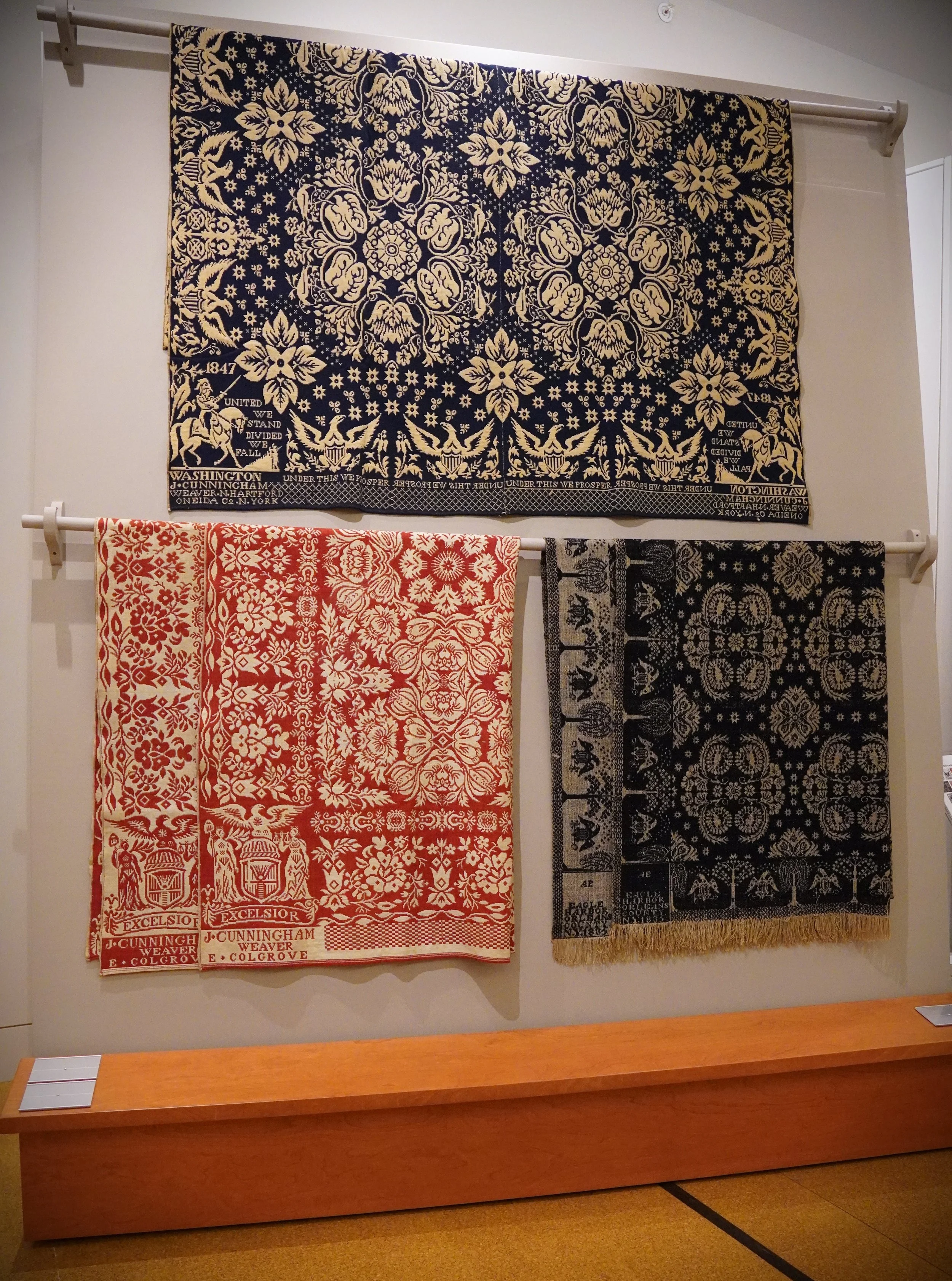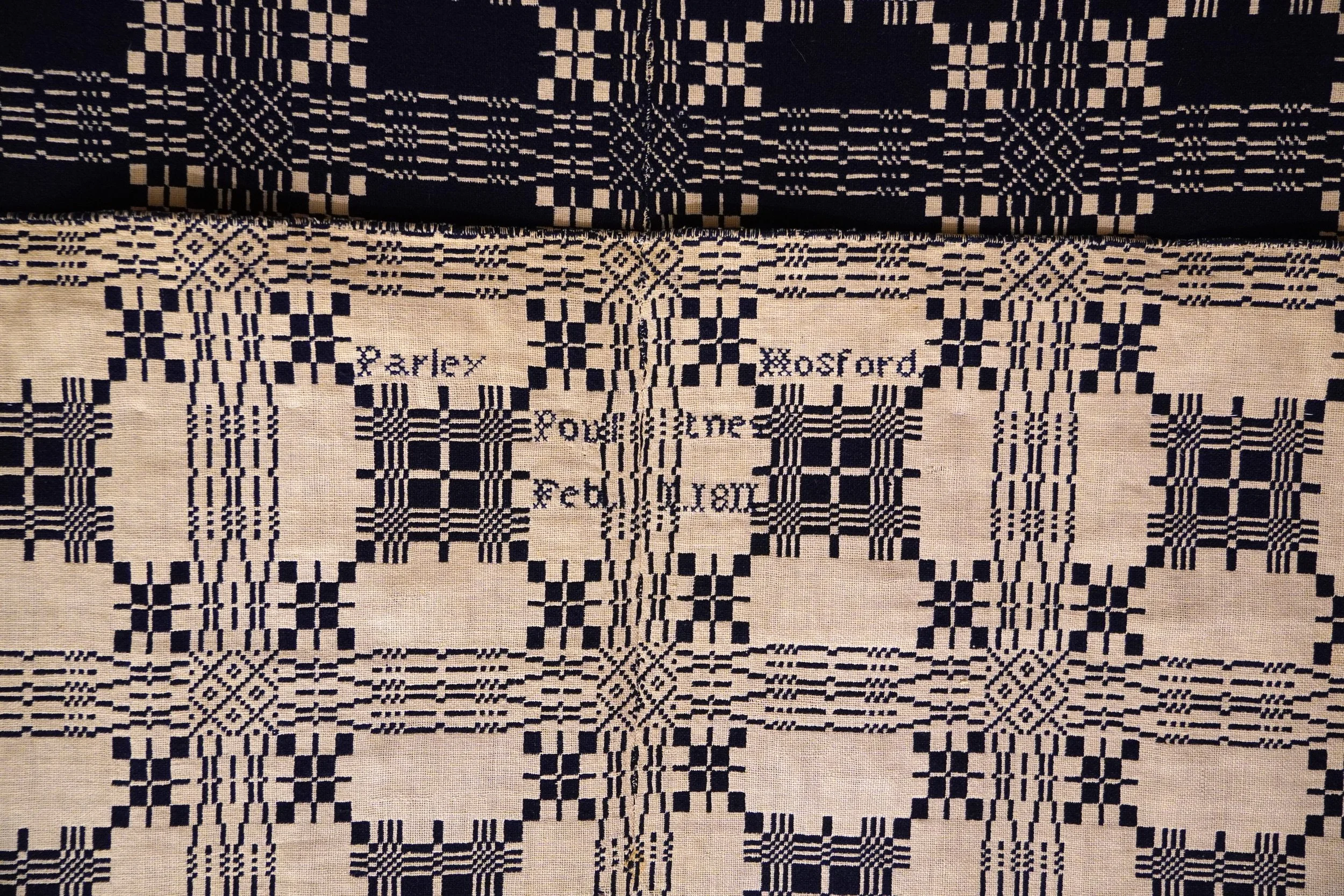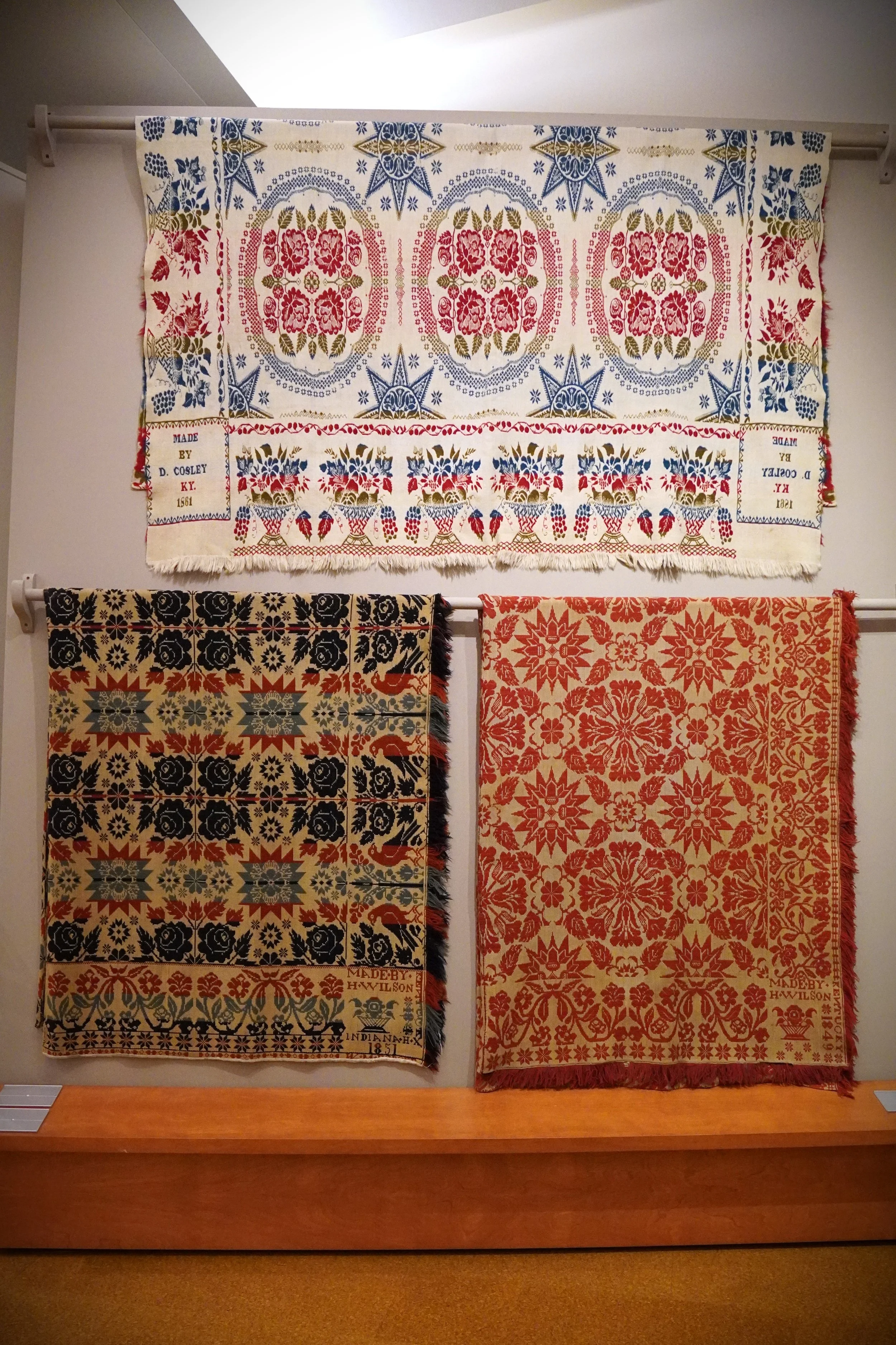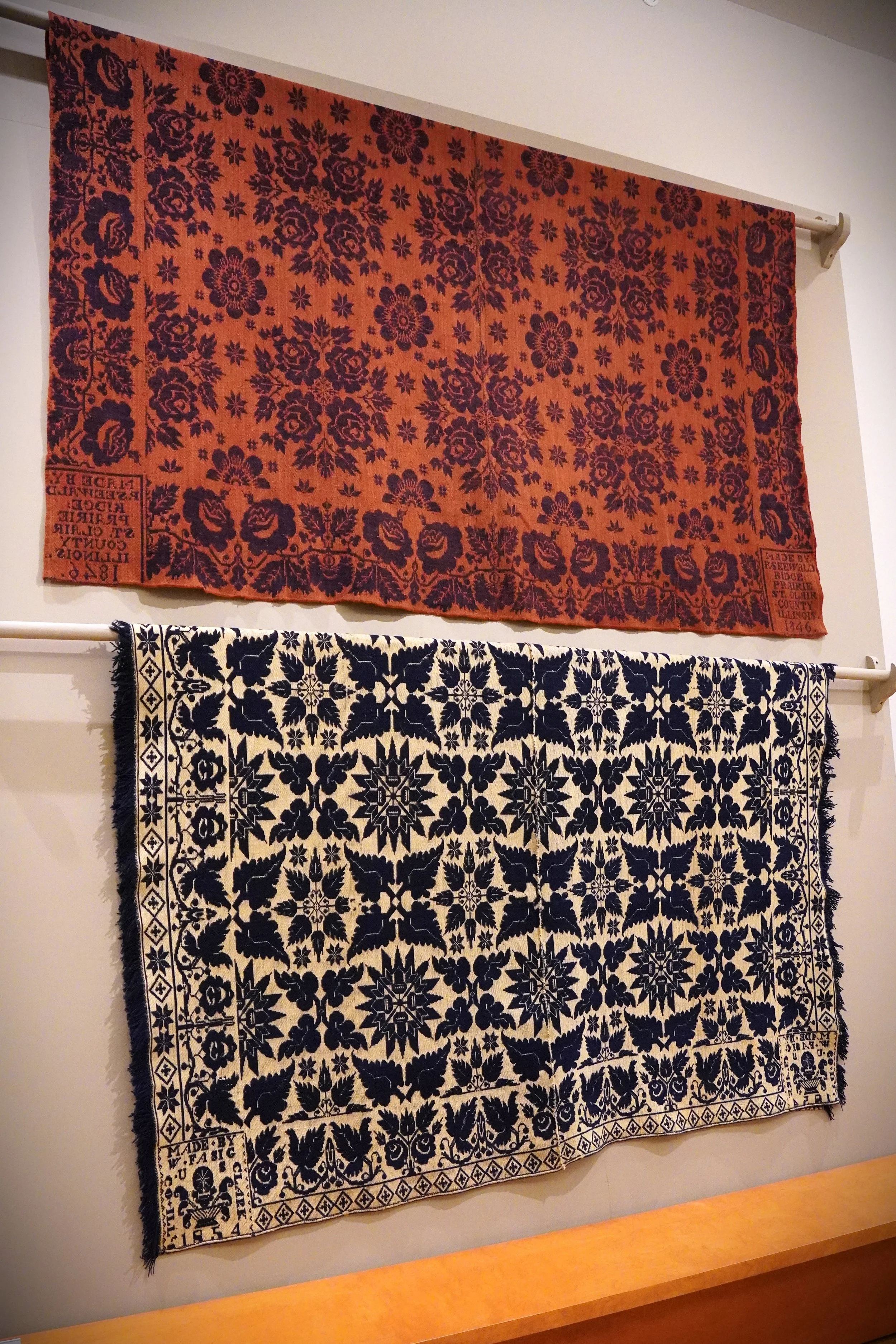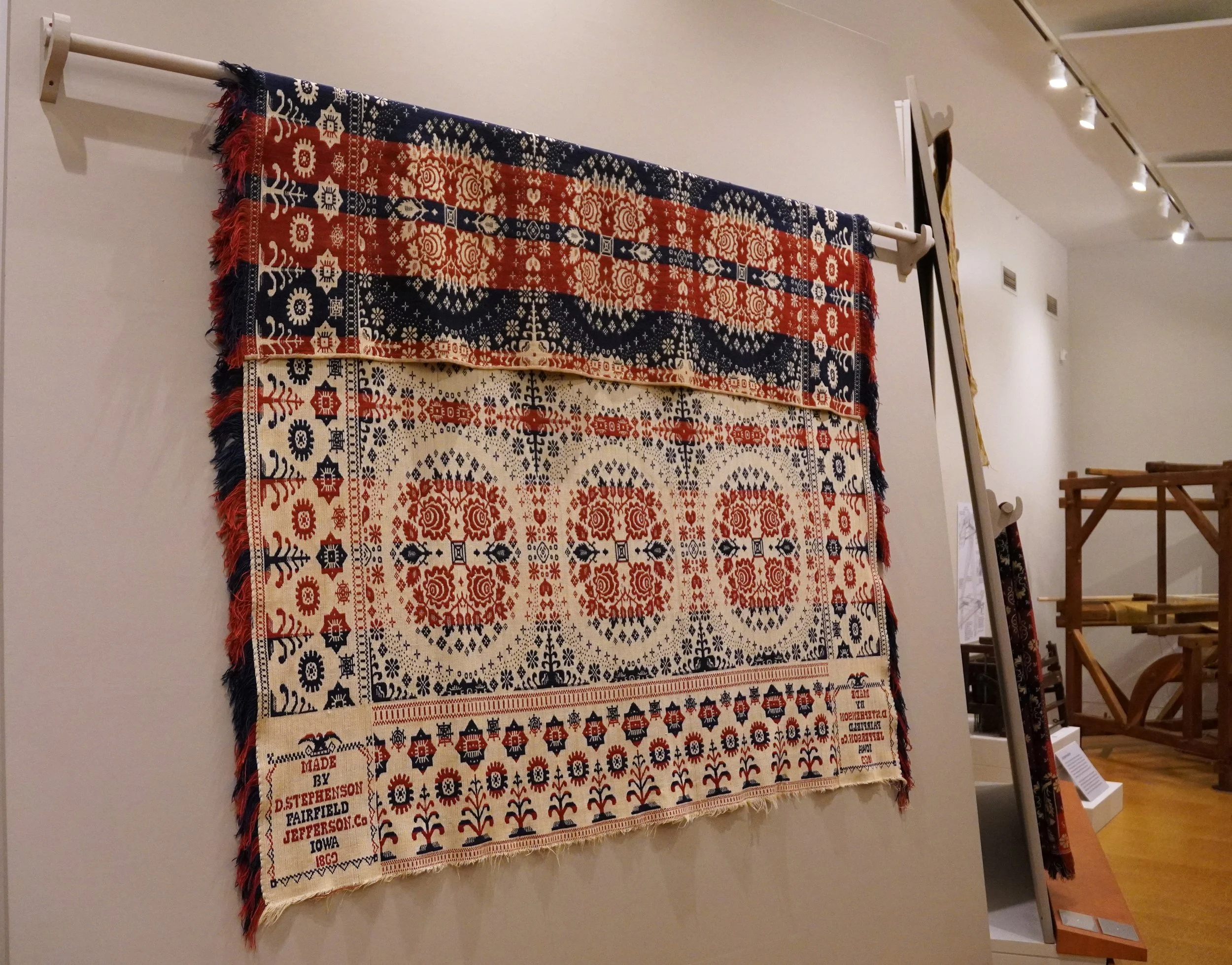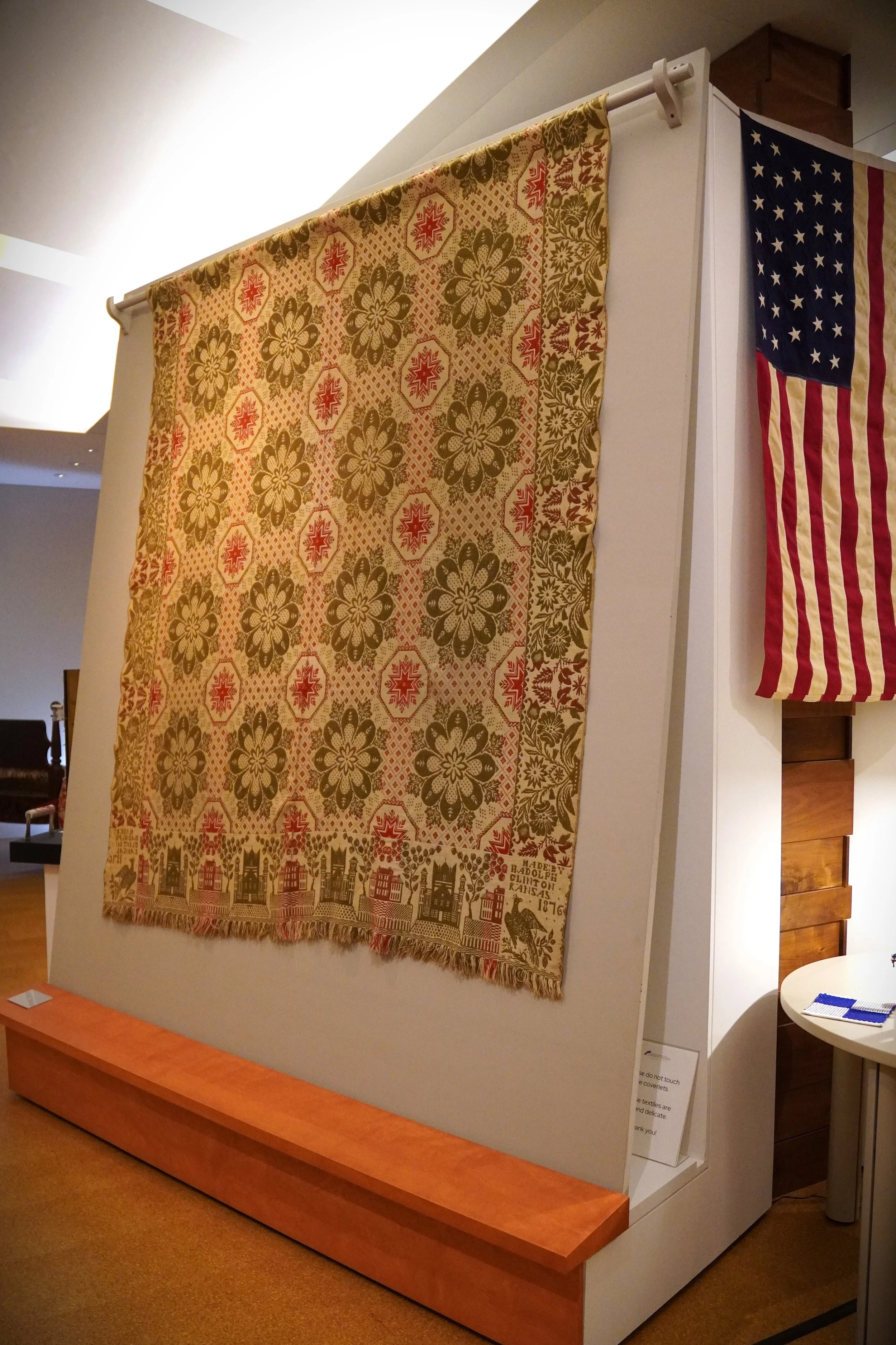-
![]()
States of the Union: A Textile Tour of Early America
The year 2026 marks the 250th anniversary of the signing of the Declaration of Independence. This exhibition honors that milestone with a collection of 19th-century handwoven bed coverlets that capture the story of a developing nation, spanning seventy years of tumultuous history and covering a geographic range from the Atlantic Ocean to west of the Mississippi. This collection of coverlets from 16 different states shows tremendous variation in color, pattern, and even fringe style.
① Power-woven in a Philadelphia factory in 1876. The nation’s centennial saw a resurgence of interest in commemorative coverlets, which were mass produced in the very factories that put most handweavers out of business by that time.
-
Pennsylvania
December 12, 1787 (2nd)
Pennsylvania German weaving traditions & folk-art designs dominate PA coverlets. Look for tulips, roses, ‘distelfink’ birds, and bright horizontal color stripes. Hundreds of handweavers wove coverlets in Pennsylvania ca. 1830 through 1850. In later decades, textile factories in eastern PA churned out countless power-woven coverlets using cheaper materials and faster methods.
② Woven by Abraham Fehr in Emmaus, Lehigh County ca. 1850. Center medallion patterns like this one, with bold horizontal color stripes, are characteristic of PA coverlets produced during the mid-century period.
③ Woven in 1840 by Samuel B. Musselman in Bucks County. Musselman wove coverlets for over twenty years, beginning in 1837.
④ Woven in 1838 by John Hamelton in central PA. The birds in this crib-size coverlet’s borders are distelfinks, a Pennsylvania-Dutch symbol of good luck and the most common of all PA borders.
-
![]()
Virginia
June 25, 1788 (VA, 10th)
June 20, 1863 (WV, 35th)Coverlet weaving took place in two main areas of modern-day West Virginia. Wheeling coverlets are multi-colored doubleweave, resembling a style popular in neighboring Ohio. Those made in the eastern panhandle of WV share more characteristics with Maryland coverlets. Many of these use the common “Lilies of France” pattern.
⑤ Woven by William Bauers in Martinsburg, Berkeley County, in what was then Virginia. Control of Berkeley County changed hands several times during the Civil War, and in 1863 it permanently became part of the newly-formed state of West Virginia. Bauers had been weaving since at least 1850, long before the split occurred.
-
Maryland
April 28, 1788 (7th)
Maryland coverlets share many features with Pennsylvania coverlets, especially those of York County. Look for tulips, roses, and the tied beiderwand weave structure in abundance.⑥ Woven in Middletown, Frederick County. These unsigned coverlets have been attributed to Frederick Uber, who advertised in 1846 that he was taking over the business of his father-in-law, Andrew Corrick.
⑦ Woven in 1870 by William Henry Gernand in Westminster, Carroll County. Gernand was the son of a coverlet weaver and began his weaving career in Graceham, Frederick County. In 1855, he bought out the weaving equipment and patterns of Pennsylvania weaver Andrew Kump, who had an established customer base in Carroll County.
-
Ohio
March 1, 1803 (17th)
In many ways, Ohio is the heartland of coverlet production, with wide-ranging styles and patterns that cannot be captured by a simple formula. Doubleweave (whether monochrome or multi-colored) and tied beiderwand in all color schemes are equally common.
⑧ Woven in 1844 by Mathias Klein in Montgomery County. The state of Ohio was home to many German-born weavers like Klein, whose colors, patterns, and weaving techniques were similar to those used in eastern Pennsylvania.
⑨ Woven in 1851 by Jesse Hart in Wilmington, Clinton County. Several Ohio weavers included moralistic sayings in their cornerblocks. This one derives from a pastoral drama by the English poet Hannah More (1773): “If good we plant not, vice will fill the place; And rankest weeds the richest soils deface.”
-
New York
July 26, 1788 (11th)
Most coverlets made in New York State are doubleweave in monochrome blue or red with white. Patriotic slogans and imagery are common here, including the famous line “Agriculture & Manufactures are the foundation of our Independence.” Several areas in New York, such as Long Island, have their own unique styles and patterns.
⑩ Woven in 1845 by James Cunningham in New Hartford, Oneida County. Coverlets from New York frequently bear patriotic slogans and imagery.
⑪ Ibid. The corner block represents the New York State coat of arms, which was formally adopted in 1778. The motto ‘Excelsior’ is Latin for ‘Higher,’ and the two female figures represent Liberty and Justice.
⑫ Woven in 1835 in Eagle Harbor, Orleans County, in western New York. Although far less common than doubleweave, the Summer & Winter weave structure is a New York specialty, especially for figured & fancy coverlets.
-
New Jersey
December 18, 1787 (3rd)
New Jersey weavers produced several distinct coverlet styles, all in monochrome doubleweave.
⑬ Woven in 1840 in Bergen County, in northern NJ. Weavers in this area used a unique set of patterns and recurring motifs. The color scheme, tufted fringe, and use of two different cornerblocks are also characteristic of coverlets from Bergen Co., which were woven there by several different weavers.
⑭ Woven in 1838 by Garret William van Doren in Millstone, Somerset County. Patriotic borders declaring ‘Liberty’ or ‘Union’ are common in New Jersey coverlets outside of Bergen Co., which share features with New York coverlets. Several weavers belonged to the van Doren family.
-
![]()
New Hampshire
June 21, 1788 (9th)
The most well-known New Hampshire coverlet weaver was Hannah Leathers Wilson, who created her “figured & fancy” patterns without the aid of punchcards on a jacquard machine or pegs on a barrel loom. Instead, she picked the patterns out by hand. This type of coverlet is called 'Bolton'-style (after the city in Lancashire, England) or 'boutonne' (Acadian French ‘buttoned’).
⑮ Woven in 1833 by Hannah Leathers Wilson for Liberty N. Whitehouse in Farmington, Strafford County. The boutonne technique involves manually pulling up small loops of weft yarn to create textured bumps or tufts on one side of the fabric. Wilson numbered the coverlets that she laboriously made this way; the highest known number is 184.
-
Vermont
March 4, 1791 (14th)
Figured & Fancy coverlets were not widely manufactured in New England. The Vermont coverlet in "States of the Union" has a simple, blocky geometric pattern. This is characteristic of coverlets made on traditional multi-shaft looms without a mechanical patterning device such as a jacquard machine or a barrel loom.
⑯ Woven in 1811 for Parley Hosford of Poultney, Rutland County. Poultney is on the New York border.
Embroidered: Parley Hosford Poultney Feb 1811
-
Michigan
January 26, 1837 (26th)
Michigan coverlet weavers were all newcomers who had started their careers elsewhere before relocating to the Great Lakes State. Each weaver brought his own style of weaving with him.⑰ Woven in 1849 by Abram W. van Doren for Electa McDonald in Avon, Oakland County. The van Doren family originally produced coverlets in New Jersey.
⑱ Woven in 1870 by Enos Michael for L. A. Lockwood in Kinderhook, Branch County. Michael also wove coverlets in Fremont, Indiana, which is less than ten miles from Kinderhook on the other side of the Indiana-Michigan border.
-
Indiana
December 11, 1816 (19th)
Dozens of patterns are completely unique to Indiana, many of exceptional intricacy and detail. Scottish-style doubleweave is most typical, though plenty of Indiana weavers wove German-style tied beiderwand as well.
⑲ Attributed to Samuel Stinger of Carthage, Rush County. Many Indiana weavers used a trademark in the cornerblock rather than signing their coverlets by name. This star logo is reminiscent of the state flag of Indiana.
⑳ Woven 1855 in New Castle, IN. This has traditionally been attributed to Samuel Graham, who appears in the 1850 census as a 46-year-old weaver in New Castle. The ornate style and borders, with birds-of-paradise and catalpa flowers, make this a classic Indiana coverlet.
㉑ Woven in 1851 by Hugh Wilson in New Winchester, Hendricks County. When Wilson moved from KY to IN, rather than designing a new cornerblock, he simply crossed out “Kentucky” on the side and added “Indiana” on the bottom.
-
Kentucky
June 1, 1792 (15th)
Coverlets survive from only four Kentucky weavers, three of whom also produced coverlets in other states as well. All of their coverlets have tied beiderwand weave structure, but there is little to define KY coverlets as distinct from other states. If anything, they exemplify the migratory tendencies of weavers, who often changed location in search of new markets.㉒ Woven in 1849 by Hugh Wilson in Shelbyville, Shelby County. Wilson’s eleven children were born in Kentucky before he relocated to Indiana around 1850.
㉓ Woven by Dennis Cosley. Cosley began to weave in Pennsylvania but spent the bulk of his weaving career in Greene County, Ohio before relocating to Kentucky. Such a trajectory is common among coverlet weavers, which explains why the distinctions between regional styles are frequently blurred.
-
![]()
Tennessee
June 1, 1796 (16th)
No known professional handweavers made coverlets in Tennessee, but power-woven coverlets were produced in Blount County, TN at the Maryville Woolen Mill, which operated from 1874 to 1906. The mill ran day and night with 44 steam and water powered looms consuming hundreds of pounds of wool daily. Its 60 workers produced textiles that included coverlets, denim, flannels, blankets, and yarn.㉔ Tennessee coverlet woven at Maryville Woolen Mills, which the stylized initials M. W. M. in the borders of this coverlet stand for. All coverlets woven there used the same pattern.
-
Illinois
December 3, 1818 (21st)
Eighteen weavers, all ethnically German, produced figured & fancy coverlets in Illinois from 1841 until after 1871. Many were recent immigrants to the United States, while others left homes and careers in the eastern U.S. Their coverlets mostly mimic the styles and patterns of Germanic weavers in Pennsylvania and Ohio.㉕ Woven in 1846 by Philip Seewald in Ridge Prairie, St. Clair County. The double rose centerfield pattern is the single most common of all coverlet patterns, used in every state where coverlets were made. An all-wool coverlet in this weave structure, on the other hand, is a rarity.
㉖ Woven in 1854 by William Fasig in Martinsville, Clark County. William and his nephew, Christian Fasig, both wove coverlets in Ohio before moving westward to establish themselves in Illinois.
-
-
Missouri
August 10, 1821 (24th)
Coverlet weaving was not a widespread industry in Missouri. The two major weavers are both represented here.Although working on opposite sides of the state, both weavers produced coverlets of a similar style in boldly colored doubleweave.㉘ Woven in 1871 by John E. Schneider in Hamburg, St. Charles County. Schneider immigrated from Germany in 1839 with a large family group. Arriving in New Orleans, they traveled up the Mississippi and Missouri Rivers to settle in Hamburg near St. Louis.
㉙ Woven in 1881 by Henry Adolph in Walnut Grove, Green County. Adolph was one of the most wide-ranging of coverlet weavers, moving from Indiana to Missouri to Kansas and back again to Missouri where he ended his career.
-
Kansas
January 29, 1861 (34th)
Henry Adolph, originally of Indiana, is the only known weaver of figured & fancy coverlets who worked in Kansas. He wove in a number of locations, traveling from Indiana to Missouri to Kansas (passing through Iowa on the way, though it is not known whether or not he produced coverlets there) before settling down back in Missouri. His coverlets from KS and MO are multi-colored doubleweaves in Indiana-style patterns.㉚ Woven in 1876 by Henry Adolph in Clinton, Douglas County. This coverlet was woven in the same year as the power-woven Centennial coverlet at the beginning of the tour. On the Kansas frontier, Adolph was insulated from direct competition with mass-produced factory textiles and managed to continue supporting himself as a skilled handweaver to a relatively late date.
-
What about everywhere else?
Jacquard looms were not used to make figured & fancy coverlets everywhere in the United States.
Overshot coverlets were made all over America and resurged in popularity in the early 1900’s. Since colonial times, overshot enabled weavers to create decorative geometric patterns on simple looms.
Counterpanes are highly textured woven bedcovers made entirely of white cotton. Relatively lightweight, they were especially popular in the South.
Quilts consist of two layers of pre-woven fabric sewn together with batting in between. They boomed in popularity after the Civil War as factory-woven cotton fabrics became cheap and readily available.
Handwoven coverlets were ultimately a short-lived phenomenon, at the height of popularity from 1830 through 1860. But to this day many thousands of coverlets still survive, handed down through the generations as cherished family heirlooms — a lasting testament to American artistry and handcraft, 250 years after the nation’s founding.
Audio tour (12 min)
Narrated by Jonah Weaver C’27, Katherine Folmar C’27, and Jack Quinn C’27


